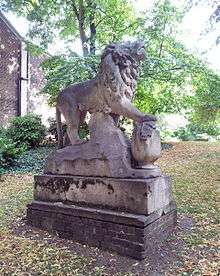Tom Cribb
| Tom Cribb | |
|---|---|
 | |
| Statistics | |
| Height | 5 ft 9 in (175 cm) |
| Nationality | British |
| Born |
8 July 1781 Bristol |
| Died |
11 May 1848 (aged 66) London |
Tom Cribb (8 July 1781 – 11 May 1848) was an English bare-knuckle boxer of the 19th century, so successful that he became world champion.
Cribb was born near Bristol but moved to London before starting professional fighting. He undertook a series of fights between 1805 and 1812 when he retired, becoming a coal merchant and then publican. His career has been commemorated with the name of a pub and in literature.
Life

Born in Wick which is near the Hanham area of Bristol, Cribb moved to London at the age of 13 and after working as a bell-hanger got work as a coal porter in Wapping.
His first fight was on 7 January 1805 at Wood Green in Middlesex, now part of north London. Victory here, followed by another a month later, persuaded him to become a professional pugilist, under the supervision of Captain Robert Barclay. In 1807 Cribb beat Jem Belcher. In 1810 Cribb was awarded the British title. On 10 December 1810 he fought an American, former slave Tom Molineaux, at Shenington Hollow in Oxfordshire.[1] Cribb beat Molineaux in 35 rounds and became World champion. The fight was controversial for two reasons: Molineaux was injured when the crowd invaded the ring, and Cribb at one point seemed to have taken longer than the specified time to return to the centre of the ring.[2] Cribb retained his title in 1811 by beating Molineaux at Thistleton Gap in Rutland in 11 rounds before a large crowd. Cribb had also beaten Molineaux's trainer Bill Richmond.
In 1812, aged 31, he retired to become a coal merchant (and part-time boxing trainer). Later he became a publican, running the Union Arms, Panton Street, close to Haymarket in central London.
George Nicholls was the only fighter to defeat Cribb (20 July 1805). The foremost prizefighting reporter, Pierce Egan, was aware that some "friends of the CHAMPION" had encouraged the myth that Cribb enjoyed an unbeaten career by "withholding the name of his vanquisher" (Boxiana, vol. 1).[3]
In 1839 he retired to Woolwich in south-east London where he died in 1848, aged 66. He was buried in the churchyard of St Mary Magadalen's, Woolwich – where a monument to his memory was erected.
Legacy

Cribb's tomb in the shape of a lion resting his paw on an urn still stands in Saint Mary's Gardens in Woolwich. Also in Woolwich, a road in the Royal Arsenal area has been named in his honour.
The Tom Cribb pub is located at 36 Panton Street, Haymarket, London. This is the same address as the Union Arms, which was numbered 26 Panton Street, but later renumbered.
There is a popular local legend in the Bristol area that Cribbs Causeway, a road not far from Hanham that has given its name to a major out-of-town shopping mall, retail park and entertainment complex, was named after Tom Cribb. Despite being proved to be false this has not stopped the legend from continuing.
Tom Hyer, first recognized American Heavyweight Champion, portrayed the character "Tom Cribb" in a scene from Pierce Egan's "Tom and Jerry, or Life in London" during a single performance at the National Theatre (Boston, Massachusetts), 9 March 1849.
An English footwear brand named after Thomas Cribb existed between 2003 - 2007. The brand name "Thomas Cribb" is currently registered to the creators of the brand.
Tom Cribb also features prominently in George MacDonald Fraser’s novel Black Ajax, a fictionalised account of Tom Molineaux's life.
He is mentioned in one episode of the Victorian crime drama Cribb, in which one of Cribb's men speculates whether he is descended from the famous boxer. The episode is largely centred on prize-fighting.
Cribb's fights with Molineaux was turned into a 2014 play by Ed Viney called Prize Fighters.[4]
Cribb´s also is mentioned in novel "MAULER" by Shawn Williamson. He appears to introduce the exotic Tasmanian Tiger (thylacine), the hero of story, also known as Mauler and Cu´chulain. Cribb introduces the dark exploration of the animal through the market of violence, explored by Captain Potter as a cruel dog fighter against mastiff dogs in White Heaven, 19th Century.[5]
See also
References and sources
- References
- ↑ Lobel, Mary D and Crossley, Alan (Eds.) (1969). Victoria County History: A History of the County of Oxford: Volume 9. pp. 171–188.
- ↑ Egan, Boxiana, Volume I, 1813.
- ↑ Snowdon, David (2013). Writing the Prizefight: Pierce Egan's Boxiana World.
- ↑ Pamela Parkes (22 June 2014). "Boxing: When a freed slave fought a sporting star". BBC News. Retrieved 22 June 2014.
- ↑ WILLIAMSON, SHAWN. MAULER. Hayloft Publishing, Cumbria. England, 2005.
- Sources
 Stephen, Leslie, ed. (1888). "Cribb, Tom". Dictionary of National Biography. 13. London: Smith, Elder & Co.
Stephen, Leslie, ed. (1888). "Cribb, Tom". Dictionary of National Biography. 13. London: Smith, Elder & Co. - Hurley, John (2009). Tom Cribb: The Life of The Black Diamond. Stroud: The History Press. ISBN 0-7524-4751-3.
- Lobel, Mary D and Crossley, Alan (Eds.) (1969). Victoria County History: A History of the County of Oxford: Volume 9. pp. 171–188.
- David Snowdon, Writing the Prizefight: Pierce Egan's Boxiana World (Bern, 2013)
External links
 Media related to Tom Cribb at Wikimedia Commons
Media related to Tom Cribb at Wikimedia Commons